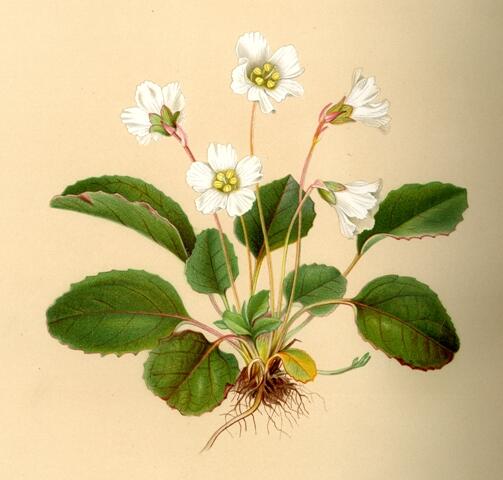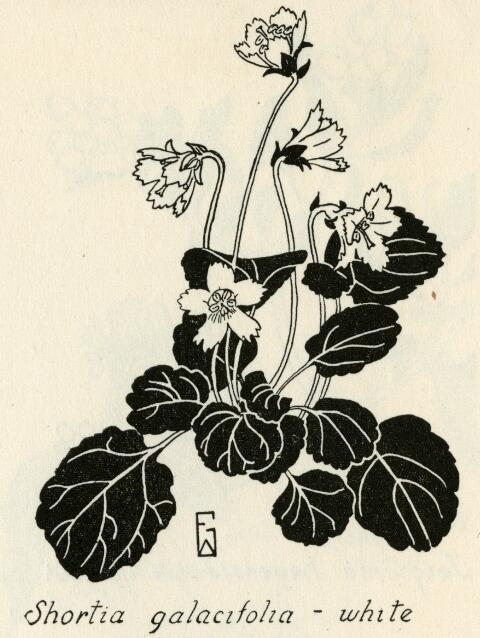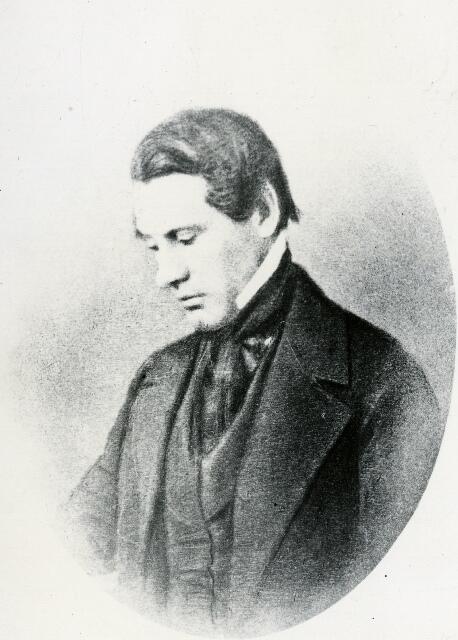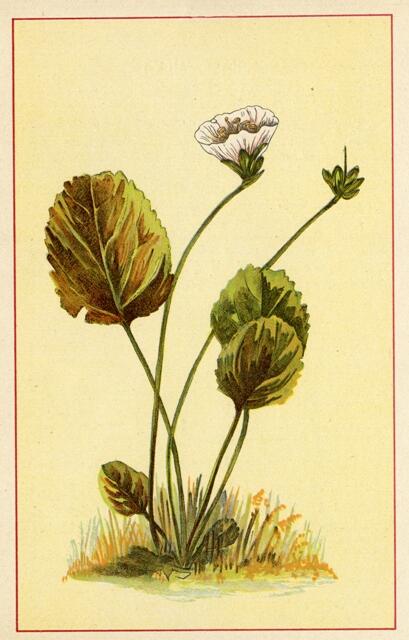Shortia galacifolia
A Plant Rediscoverd

This is the story of a botanical mystery. A treasure hunt for a small, modest plant that eluded great botanists for generations. While working in the field, botanists will often write or sketch locations in which discoveries were made ... these notes and maps could potentially be misread, misunderstood, or simply misplaced by future generations. Without a full account of where and when a plant was discovered, something of a botanical treasure hunt can result. It was one of these such situations that plagued the mind of Asa Gray for nearly forty years; when a little plant became the Holy Grail for botanists. The story of Shortia galacifolia (commonly known as Oconee bell) begins in December of 1788 when a French botanist by the name of Andre Michaux was botanizing in the United States. Mixhaux kept a journal during his travels, written in French. Through his journal, as through the journals of other great early explorers, we are able to relive the adventures and hardships of his work in the field. Michaux wrote:
"The roads became more difficult as we approached the headwaters of the Keowee on the 8th of December, 1788... Two miles before arriving there I recognized the Magnolia motana which has been named M. cordata or auriculata by Bartram. There was in this place a little cabin inhabited by a family of Cherokee Indians. We stopped there to camp and I ran off to make some investigations. I gathered a new low woody plant with saw-toothed leaves creeping on the mountain at a short distance from the river. The weather changed and it rained all night. Although we were in the shelter of a great Strobus pine our clothing and our covers were soaked. About the middle of the night I went to the cabin of the Indians, which could scarcely hold the family composed of eight persons, men and women. There were besides six big dogs who added to the filth of this apartment and to its inconveniences. The fire was placed in the middle without any opening in the top of the cabin to let the smoke out; there were plenty of holes, however, to let the rain through the roof of this house. An Indian came to take my place by the fire and offered me his bed which was a bear's skin. But finally the rain having stopped and annoyed by the dogs which kept biting each other continually to keep their place by the fire, I returned to the camp."
Further on in his journal Michaux wrote: "I came back to the camp with my guide at the head of the Keowee and gathered a large quantity of the low woody plants with the saw-toothed leaves that I found the day I arrived. I did not see it on any other mountain. The Indians of the place told me that the leaves had a good taste when chewed and the odor was agreeable when they were crushed, which I found to be the case."
"The head of the Keowee is the junction of two torrents of considerable size which flow in cascades from the high mountains. This junction takes place in a small plain where there was once a Cherokee village. On descending from the junction of these two torrents with the river to one's left and the mountains which face north on the right one finds at about 200-300 feet from the junction, a path formed by the Indian hunters. It leads to a brook where one recognizes the site of an Indian village by the peach trees which still exist in the midth of the underbrush. Continuing on this path one soon reaches the mountains and one finds this plant which covers the ground along with the Epigaea repens."

Michaux sent many specimens from the United States home to France, among them the the low woody plant described in his journal. An incomplete and somewhat misleading label on the herbarium specimen read "Hautes montagnes de Carolinie" (High mountains of Carolina), which contradicted the location Michaux had written in his journal. The specimen of this mysterious plant was housed in a herbarium cabinet in France and remained untouched until 1839. Asa Gray was on a year's absence from the University of Michigan at Ann Arbor and was on a trip to examine the original sources of American flora as they existed in the principal herbia of Europe. In March of this year Gray reached Paris, where he worked over the collections of Andre Michaux. In a cabinet of unidentified plants Gray came across a faded dry specimen with the label "Hautes montagnes de Carolinie". His interest was piqued, but his time in France was short, and he was obliged to return to work shortly thereafter. Having found the specimen, Gray claimed the right to name the plant, and thus called it Shortia, after a botanist from Kentucky, Charles Wilkin Short.
 Gray returned from his trip abroad in November of 1839 and went back to his work on the Flora of North America. It was not until 1841 that Gray, along with his friends John Carey and James Constable, first went in search of the mysterious plant. Relying almost entirely on Michaux's reference to the High Mountains, Gray and his companions searched in areas over 5000 feet in height. In correspondence written for Sir William Hooker Gray wrote: "We were unsuccessful in our search for a remarkable undescribed plant with a habit of Pyrola and the foliage of Galax, which was obtained in the high mountains of Carolina. The only specimen extant is amount the 'Plantae incognitae' of the Michauxian herbarium, in fruit only; and we were anxious to obtain flowering specimens, that we might complete its history; as I have long wished to dedicate the plant to Professor Short, of Kentucky, whose attainments and eminent services to North American botany are well known and appreciated both at home and abroad.
Gray returned from his trip abroad in November of 1839 and went back to his work on the Flora of North America. It was not until 1841 that Gray, along with his friends John Carey and James Constable, first went in search of the mysterious plant. Relying almost entirely on Michaux's reference to the High Mountains, Gray and his companions searched in areas over 5000 feet in height. In correspondence written for Sir William Hooker Gray wrote: "We were unsuccessful in our search for a remarkable undescribed plant with a habit of Pyrola and the foliage of Galax, which was obtained in the high mountains of Carolina. The only specimen extant is amount the 'Plantae incognitae' of the Michauxian herbarium, in fruit only; and we were anxious to obtain flowering specimens, that we might complete its history; as I have long wished to dedicate the plant to Professor Short, of Kentucky, whose attainments and eminent services to North American botany are well known and appreciated both at home and abroad.
In 1843 Gray, with his friend William Sullivant, spent three months searching the same territory for his mysterious plant. Again, he was unsuccessful. Gray was not the only botanist in search of this mysterious plant. Shortia had become a treasure hunt for many important botanists of the day. In September of 1851 M.A. Curtis wrote to Dr. Short; "I rather think, if I had a whole summer to myself in those "hautes montagnes", that I could bring it to light. I would give no small sum to rediscover it." John Torrey wrote to Dr. Short in August of 1851 "I wish you would send a young botanist into the mountains of North Carolina to look for Shorta. What would I not give to see complete specimens of that plant!" Torrey writes further on "If I had less to do at home, I would find it, if it has not become an extinct species."
In 1858 Asa Gray studied a collection of Maximowicz's Japanese plants and recognized in his Scizocodon uniflorus another species of Shortia almost identical with the Carolina plant. While the Japanese specimens confirmed the validity of the genus, they gave no more information on the mysterious Carolina plant which no botanist could find.
In 1863 Charles Short passed away; having never seen the specimen of Shortia in the Paris herbarium or witnessed his namesake growing in the wild. In a memorial Asa Gray penned for Dr. Short, Gray wrote "Two or three species of Kentucky plants commemorate the name of Dr. Short as their discoverer. Also a new genus, Shortia, inhabiting the Alleghany Mountains, was dedicated to him by the present writer. But, alas! too like the botanist for whome it was named, it is so retiring in its habits that it is not known as it ought to be, but lives as yet unseen, except by a single botanist of a former generation, in some secluded recess of the Black Mountain of North Carolina. It will some day be found again and appreciated."
In the end it was not Gray, nor Torrey, nor any botanist who discovered the plant in the wild. In May of 1877 a seventeen year old boy named George McQueen Hyams, of Statesville, N.C. was walking beside the Catawba River when he came across a plant he did not recognize. His father, an amateur botanist, sent the specimen to a friend, who in turn wrote to Gray, telling him he thought he had Shortia. In a letter written by Alice Gray in June of 1928, Alice remembers her uncle, Asa Gray, receiving a specimen of the "lost plant" after its rediscovery. Alice recalls her uncle crying "Eureka! Eureka!" to her aunt, upon its arrival.
The search was over.
Charles Wilkin Short was never able to view the herbarium specimen, or see his namesake growing in the wild. In a letter to Dr. Short's daughter written in August of 1879, Gray says "Year after year have I hunted for that plant! and I grew sorrowful at having named after Dr. Short a plant that nobody could find. So conspicuous for its absence had this rarity become, that friends of ours, botanizing in the mountains two years ago, were accosted with the question - "Found Shortia yet?" from people who had seen our anxious search for it. After all, the rediscovery was accidental, and by one not a botanist. Few botanical events have excited more interest at home and abroad; and your honored father is commemorated by perhaps the most interesting flower in N. America, with a counter-part in Japan."
In 1879 Gray organized an excursion to see Shortia growing in the wild. He, his wife, and three other botanists were in the exploring party. Gray says that it was a delightful journey, during which they encountered a small partch of Shortia at the foot of the mountains. Gray expresses regret that he did not find the plant growing higher in the mountains where he thought it had been originally discovered by Michaux, but says "I am not yet 69 years old, and I hope to try once more, having now narrowed the region in which the search should be made with some confidence."
In 1888 Charles S. Sargent visited the mountain region of North and South Carolina, using Michaux's journal as a guide. Following the described location, Sargent found the fertile plain at the junction of the two streams. He came across the footpath, which, "since trodden by the feet of many moonshiners", still existed. Sargent wrote "It was by the side of this path that Michaux, just 100 years ago this month, discovered his 'Arbuste', which denticulate leaves, and here, ninety-eight years later, I found Shortia."
Shortia galacifolia was never found in the mountains, as it grows in lower elevations. It was the reference "Hautes montagnes de Carolinie" written on the Paris herbarium sheet that inspired the minds of generations of explorers, and brought great scientists trudging to mountaintops in a botanical goose chase. Asa Gray's brief first encounter with the mysterious specimen kept his interest peaked for many years. Thankfully he was able to see its resolution while he had the time and strength to visit his little white flowers growing in the wild.

References
Gray, Asa. Letters of Asa Gray. New York: Houghton, Mifflin, and Co., 1893.
Jenkins, Charles F. Asa Gray and his quest for Shortia galacifolia (1942). Arnoldia, Vol. 2 No. 3-4, pp. 13-28.
Sargent, C.S. Some remarks upon the journey of Andre Michaux to the high mountains of Carolina, in December, 1788, in a letter addressed to Professor Asa Gray (1886). American Journal of Science, Vol. 32, pp. 466-473.
Sargent, C.S. The Story of Shortia (1888). Garden and Forest, Vol. 1, pp. 506-509.
Savage, Henry and Elizabeth Savage. Andre and Francois Andre Michaux, Charlottesville: University Press of Virginia, 1986.
Asa Gray Correspondence, Gray Herbarium Archives, Cambridge, Massachusetts.